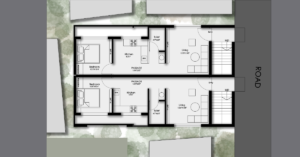Concrete is one of the most used materials in construction. It’s strong and long-lasting but when building structures like beams, slabs, and pavements, we don’t just care about how well concrete handles pressure from above (compressive strength), we also care about how well it can resist bending. That’s where flexural strength comes in.
In this article, we’ll break down what flexural strength of concrete means, how to find it, how to calculate it, and what the typical values are without getting too technical.
Table of Contents
ToggleWhat is Flexural Strength of Concrete?
Flexural strength, also called modulus of rupture, is the ability of concrete to resist bending or cracking under load. In simple words, it tells you how strong the concrete is when it’s being bent.
Imagine a concrete beam. If you put a load in the middle, the beam will bend. The flexural strength tells us how much it can bend before it cracks or breaks.
Why is Flexural Strength Important?
Flexural strength is especially important in:
Roads and pavements (to handle moving vehicle loads)
Slabs and beams (to avoid cracking and sagging)
Bridges and cantilevers (where bending forces are common)
If the flexural strength is too low, the concrete may crack even if it has high compressive strength.
How to Find Flexural Strength of Concrete
Flexural strength is tested in a lab using a beam test, which involves breaking a small concrete beam under controlled conditions.
There are two common test methods:
Center Point Loading Test
Load is applied in the middle of the beam.
Measures the maximum stress at the center.
Third Point Loading Test
Load is applied at two points, dividing the beam into three equal parts.
Measures average stress in the middle section.
These tests are done according to standards like IS 516 (India) or ASTM C78 (USA).
Flexural Strength of Concrete Formula
The flexural strength (fᵣ) is calculated using the formula below (for third-point loading):
fᵣ = (P × L) / (b × d²)Where:
fᵣ = Flexural strength in MPa or N/mm²
P = Maximum load applied (in Newtons)
L = Length between the supports (in mm)
b = Width of the beam (in mm)
d = Depth of the beam (in mm)
For center point loading, a slightly different formula is used.
The Flexural Strength of Concrete Is…
The flexural strength of concrete depends on the grade and mix of concrete. Here’s a general idea:
| Concrete Grade | Flexural Strength (Approx.) |
|---|---|
| M20 | 3.0 – 3.5 MPa |
| M25 | 3.5 – 4.0 MPa |
| M30 | 4.0 – 5.0 MPa |
A common rule of thumb is:
Flexural strength ≈ 10% to 20% of compressive strength
So, if your concrete has a compressive strength of 30 MPa, the flexural strength might be around 3 to 4.5 MPa.
How to Increase Flexural Strength of Concrete
To make concrete stronger against bending, you can:
Use higher-grade cement
Add steel fibers or polypropylene fibers
Ensure proper curing of concrete
Use admixtures to improve bonding and reduce voids
Avoid excess water in the mix
Why Flexural Strength Value Matters
Design Safety: Ensures that beams, slabs, and pavements don’t crack under load.
Durability: Helps prevent long-term structural damage.
Quality Check: Used to evaluate the consistency and quality of concrete mixes.
Knowing the flexural strength of concrete value helps engineers and architects choose the right type of concrete for your structure.
Need Help with Concrete Design or Slab Planning?
At SmartScale House Design, we don’t just design homes we ensure every structural element, including your slabs and beams, meets the right standards for strength and durability.
Whether you’re building a new house or improving an existing one, our team can guide you through proper concrete usage, slab design, and structural planning.
Contact SmartScale House Design today to get expert advice and custom plans tailored for your home.
Conclusion
Flexural strength might not be as commonly talked about as compressive strength, but it’s just as important especially in structures that deal with bending and movement. Knowing how to measure and improve it can help make your construction stronger and more durable.







